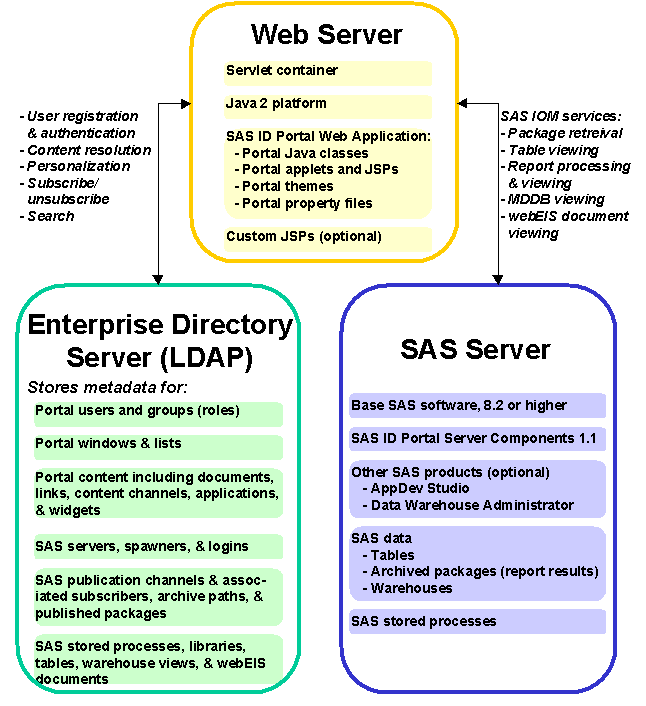Adding SAS® Content
The SAS Information Delivery Portal exploits the analytical and reporting powers of SAS by allowing you to deliver SAS data to the desktop of portal users. Through the portal, authorized users can perform the following functions from client machines that have only a Web browser installed:
- View SAS tables
- Run SAS reports, known as "stored processes"
- Subscribe to SAS publication channels, and view packages that are published to these channels
- View SAS data warehouses
- View SAS webEIS documents
The following diagram shows how the SAS Information Delivery Portal web application, residing on a web server, interacts with the enterprise directory server and the SAS IOM server to provide this functionality for multiple users:
Before you can add SAS data and functionality to the SAS Information Delivery Portal, the following prerequisites must be in place:
- The following software must be installed on the SAS server:
- Base SAS software, Release 8.2 or higher
- SAS Information Delivery Portal Server Components
- Any other SAS products needed to support content types that you wish to host in the portal (for example, AppDev Studio for webEIS documents and Warehouse Administrator for warehouse views).
- The following metadata must be present on the enterprise directory server. To manage these definitions and to create new ones, you can use the Integration Technologies Administrator application. For details, refer to the
SAS Integration Technologies Administrator
page on the SAS Integration Technologies Web site. The required definitions are as follows:
- SAS server definition. A Portal Demo Server is automatically defined when you follow the portal's installation process. The metadata for a SAS server includes:
- Server name
- Machine name
- Logical name. The portal uses the logical name to associate the servers to related objects on the enterprise directory. Be sure to use the same logical name when you define spawners, logins, and libraries for this server.
- Connection information, including domain name and protocol
- Other information including encryption, commands, and workspace pooling, as required.
For an example of the process for creating a server definition, refer to the SAS Server Metadata Example.
- SAS spawner definition. The IOM object spawner is a daemon that listens for incoming client requests for IOM services. When the daemon receives a request from a new client, it launches an instance of an IOM server to fulfill the request. A Portal Demo Spawner is automatically defined when you follow the portal's installation process. The spawner definition should include the following:
- Spawner name
- Machine name
- Logical name (this must match the logical name of the associated server)
Instructions for administering and starting an object spawner are available from the
Starting and
Administering an Object Spawner
page on the SAS Integration Technologies Web site. For an example of the process for creating a spawner definition, refer to the SAS Spawner Metadata Example.
- SAS login definition. SAS logins are a convenient method for providing the credentials necessary for a spawner to start a SAS session. Using logins, the spawner can create SAS sessions without having to keep track of the specifics of a user's ID and permissions. A Portal Demo Login is automatically defined when you follow the portal's installation process. The login definition should include:
- Login name
- Person reference, including the distinguished names of individual portal users or groups of users who will be allowed to access the SAS server through the portal
- Login, consisting of the SAS login and password needed to access to SAS server
- Domain name
- Logical name (this must match the logical name of the associated server)
For an example of the process for creating a login definition, refer to the
SAS Logins Metadata Example.
- The IOM Object Spawner must be running on the SAS server. Instructions for administering and starting an object spawner are available from the
Starting and
Administering an Object Spawner
page on the SAS Integration Technologies Web site. The following is an example of a spawner command that works with the SAS System,
Release 8.2 and runs the Portal Demo on the Windows platform:
del /q c:\temp\obj.log
"c:\program files\sas institute\sas\v8\inttech\sasexe\objspawn"
-sasverbose -saslogfile c:\temp\obj.log
-ldaphost ldapserver.ace.com -ldapport 389
-ldapbase "sascomponent=sasServer,cn=SAS,o=ACE Industries,c=US"
-ldap_binddn "cn=Portal User,ou=People,o=ACE Industries,c=US"
-ldap_bindpw portal1 -sasspawnercn "Portal Demo"
The following is an example of a spawner command that works with the SAS System,
Release 8.2 and runs the Portal Demo on the UNIX platform:
rm /tmp/obj.log
/sas/inttech/sasexe/objspawn
-sasverbose -saslogfile /tmp/obj.log
-ldaphost ldapserver.ace.com -ldapport 389
-ldapbase "sascomponent=sasServer,cn=SAS,o=ACE Industries,c=US"
-ldap_binddn "cn=Portal User,ou=People,o=ACE Industries,c=US"
-ldap_bindpw portal1 -sasspawnercn "Portal Demo"
When the above prerequisites are in place, you can proceed to add SAS content as described in the following topics:









